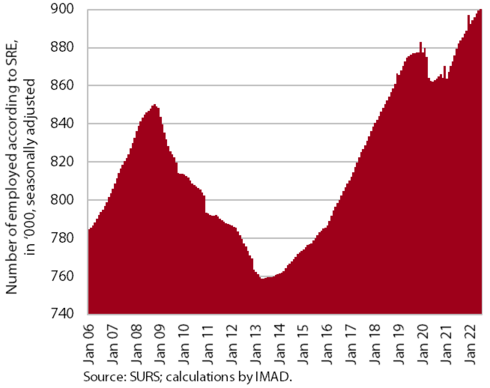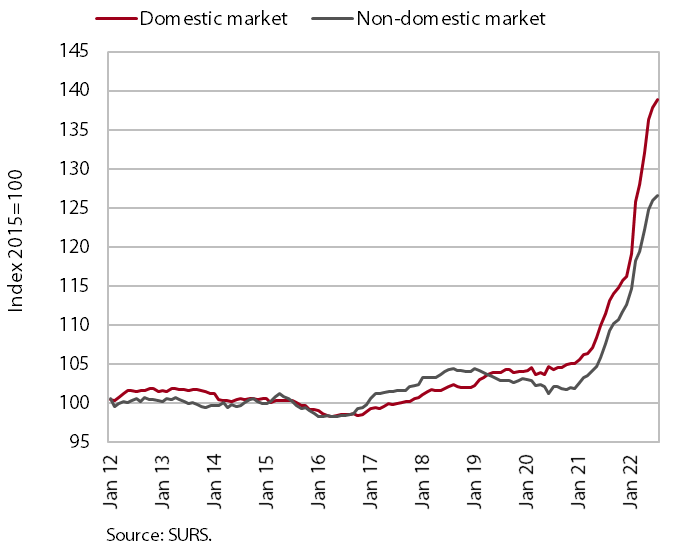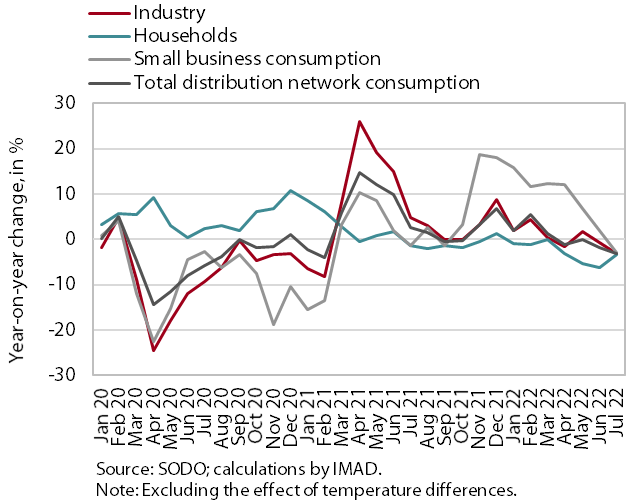Charts of the Week
Current economic trends from 17 to 19 August 2022: number of persons in employment, slovenian industrial producer prices and electricity consumption by consumption group
The number of persons in employment continues to increase, albeit at a slower pace. Among them, the share of foreigners further increased, mainly due to the shortage of local labour (most pronounced in accommodation and food service activities, administrative and support service activities and construction). The year-on-year increase in Slovenian industrial producer prices slowed down slightly for the second month in a row in July, but still remained relatively high (prices rose by more than one fifth). The slowdown in growth was most pronounced in the intermediate goods and capital goods groups. Electricity consumption in July was lower year-on-year in all consumption groups, which may reflect higher electricity prices, supply chain problems and labour shortage in certain activities.
Number of persons in employment, June 2022

The number of persons in employment reached an all-time high in June; it was 2.4% higher year-on-year, which is the lowest increase in the first half of this year. It was still very high in accommodation and food service activities and in construction. As the economy recovered, growth in the number of persons in employment again depended largely on the employment of foreign workers, whose contribution to overall year-on-year growth was 68% in June. Growth in the share of foreigners among all persons in employment also continued, rising by 1.3 p.p. to 13.4% (in June 2022) over the last year. This is largely due to the shortage of local labour, which (given the high job vacancy rates) is greatest in accommodation and food service activities, administrative and support service activities and construction. Activities with the largest share of foreigners are construction (46%), transportation and storage (32%) and administrative and support service activities (25%).
Slovenian industrial producer prices, July 2022

After rising steadily since the beginning of last year, Slovenian industrial producer prices fell slightly year-on-year for the second month in a row in July, but still remained high at 21.2%. Price growth slowed in both the domestic and foreign markets. Year-on-year price growth slowed most in the intermediate goods and capital goods groups, where prices rose by 24.1% and 12.6% respectively. The year-on-year increase in the prices of energy and consumer goods continues to strengthen, reaching almost 75% and 12.2% respectively in July. Prices of consumer goods started to rise several months after prices of products in other groups. Both durable goods and consumer goods prices are picking up (they rose by 10% and 12.9% respectively).
Electricity consumption by consumption group, July 2022

In July, electricity consumption in the distribution network was lower year-on-year in all consumption groups, with one fewer working day this July. Industrial consumption was 3% lower year-on-year in July, as was small business consumption. The high growth rates of the latter were interrupted, mainly because the low base effect dissipated. According to our estimates, industrial electricity consumption and small business electricity consumption were lower year-on-year mainly due to higher electricity prices, supply chain problems and problems related to labour shortage. Household consumption was also lower (by 3.4%) than a year ago, which we associate with higher household electricity prices.
